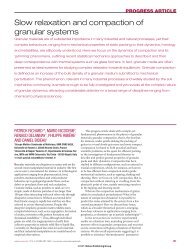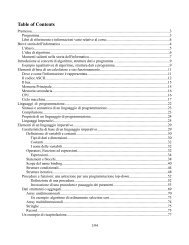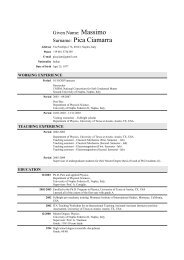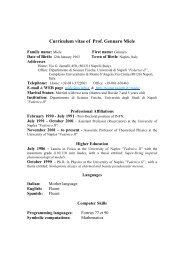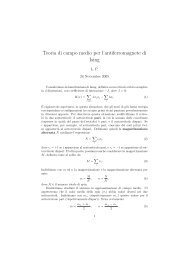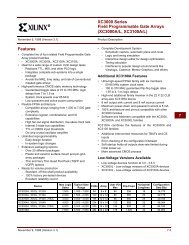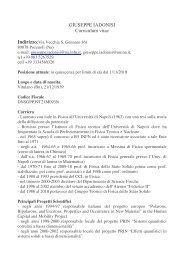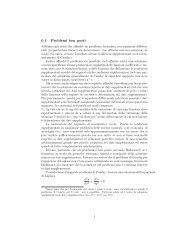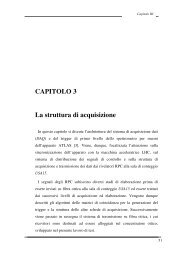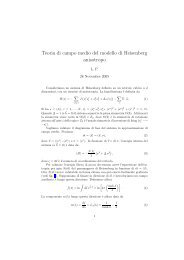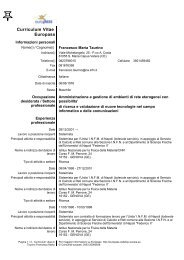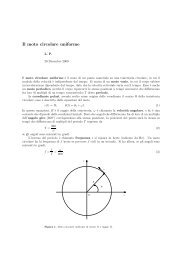Michelangelo Ambrosio - INFN Napoli
Michelangelo Ambrosio - INFN Napoli
Michelangelo Ambrosio - INFN Napoli
You also want an ePaper? Increase the reach of your titles
YUMPU automatically turns print PDFs into web optimized ePapers that Google loves.
Le nanotecnologie per la Fisica<br />
Fondamentale e Applicata<br />
<strong>Michelangelo</strong><br />
<strong>Ambrosio</strong><br />
Dirigente di<br />
Ricerca<br />
<strong>INFN</strong> – Sezione<br />
di <strong>Napoli</strong><br />
<strong>Michelangelo</strong> <strong>Ambrosio</strong> - <strong>INFN</strong> <strong>Napoli</strong> Incontro con Ingegneri - Bari, 5 aprile 2012
La Fisica subnucleare<br />
Fisica delle interazioni fondamentali<br />
Fisica del quark B e dei mesoni K<br />
Violazione di CP<br />
ATLAS<br />
CERN - Ginevra<br />
CMS<br />
<strong>Michelangelo</strong> <strong>Ambrosio</strong> - <strong>INFN</strong> <strong>Napoli</strong> Incontro con Ingegneri - Bari, 5 aprile 2012
La Fisica subnucleare<br />
Fisica delle interazioni fondamentali<br />
Fisica del quark B e dei mesoni K<br />
Violazione di CP<br />
CMS<br />
BABAR<br />
Stanford (USA)<br />
DAFNE/KLOE<br />
Lab. <strong>INFN</strong> Frascati<br />
<strong>Michelangelo</strong> <strong>Ambrosio</strong> - <strong>INFN</strong> <strong>Napoli</strong> Incontro con Ingegneri - Bari, 5 aprile 2012
La Fisica delle astroparticelle<br />
Fisica Astroparticellare<br />
Fisica del Neutrino<br />
OPERA<br />
Gran Sasso<br />
AUGER<br />
Argentina<br />
<strong>Michelangelo</strong> <strong>Ambrosio</strong> - <strong>INFN</strong> <strong>Napoli</strong> Incontro con Ingegneri - Bari, 5 aprile 2012
La Fisica astroparticellare<br />
Fisica della Radiazione cosmica<br />
Ricerca di Onde gravitazionali<br />
VIRGO<br />
PAMELA<br />
Cascina (Pisa) Nello spazio<br />
<strong>Michelangelo</strong> <strong>Ambrosio</strong> - <strong>INFN</strong> <strong>Napoli</strong> Incontro con Ingegneri - Bari, 5 aprile 2012
Astrofisica nucleare<br />
Fasci esotici<br />
Fusione/Fissione<br />
Multiframmentazione<br />
Collisioni di ioni pesanti<br />
ALICE<br />
CERN (Ginevra)<br />
La fisica nucleare<br />
8πLP<br />
Lab. <strong>INFN</strong> Legnaro<br />
<strong>Michelangelo</strong> <strong>Ambrosio</strong> - <strong>INFN</strong> <strong>Napoli</strong> Incontro con Ingegneri - Bari, 5 aprile 2012
Stringhe e Teoria dei campi<br />
Fenomenologia delle inter. fond.<br />
Nuclei e Materia nucleare<br />
Metodi matematici<br />
Fisica delle Astroparticelle<br />
La Fisica<br />
Teorica<br />
<strong>Michelangelo</strong> <strong>Ambrosio</strong> - <strong>INFN</strong> <strong>Napoli</strong> Incontro con Ingegneri - Bari, 5 aprile 2012
Ricerche tecnologiche<br />
e interdisciplinari<br />
Rivelatori<br />
Elettronica<br />
Fisica medica<br />
Radioprotezione<br />
Fisica degli acceleratori<br />
Cavità in rame<br />
Mammografia<br />
Large Area Silicon array<br />
<strong>Michelangelo</strong> <strong>Ambrosio</strong> - <strong>INFN</strong> <strong>Napoli</strong> Incontro con Ingegneri - Bari, 5 aprile 2012
L’interesse interesse nelle nuove tecnologie<br />
L’interesse dell’<strong>INFN</strong> nelle nuove tecnologie e nei nuovi materiali è stato sempre<br />
vivo e attento, pur non essendo tra i suoi obiettivi primari. Ed ha avuto importanti<br />
ricadute tecnologiche specie nel campo medico e nell’elettronica.<br />
Questo interesse è principalmente dovuto alla necessità di sviluppare sempre<br />
nuovi e più efficienti rivelatori per gli esperimenti di fisica nucleare e subnucleare.<br />
Per questo motivo negli ultimi anni la tecnologia del silicio ha avuto una grande<br />
importanza per l’<strong>INFN</strong> ed ha permesso di realizzare rivelatori di radiazione e di<br />
particelle estremamente sofisticati e di raggiungere scale di integrazione<br />
elevatissime nei circuiti integrati.<br />
Ma le nuove sfide degli esperimenti previsti nel prossimo decennio richiedono<br />
l’apertura di nuove vie e il raggiungimento di nuovi obiettivi.<br />
In particolare l’attenzione<br />
l attenzione è ora rivolta<br />
anche alle nanotecnologie.<br />
<strong>Michelangelo</strong> <strong>Ambrosio</strong> - <strong>INFN</strong> <strong>Napoli</strong> Incontro con Ingegneri - Bari, 5 aprile 2012
Motivazioni per la fisica nello spazio<br />
Il piano Cosmic Vision 2015-2025 per il progetto scientifico ESA cita:<br />
"The proposed mission will be based on large openings and large field-of-view<br />
optics with high throughput, as well as on large area, highly pixelled, fast<br />
and high detection efficiency near-UV camera".<br />
Pertanto è necessario iniziare lo sviluppo di matrici di rivelatori a singolo fotone<br />
altamente granulari e di grande superficie, con alta efficienza e basso costo,<br />
sensibili alla radiazione UV.<br />
Ovviamente rivelatori che al momento non esistono.<br />
<strong>Michelangelo</strong> <strong>Ambrosio</strong> - <strong>INFN</strong> <strong>Napoli</strong> Incontro con Ingegneri - Bari, 5 aprile 2012
Motivazioni per la fisica con<br />
PID (Particle ID<br />
acceleratori<br />
I dispositivi PID IDentification) basati sulla tecnica del Cherenkov<br />
imaging costituiscono attualmente un ingrediente essenziale per molti<br />
esperimenti di fisica adronica: il progresso delle ricerca fondamentale nella<br />
Fisica Adronica richiede un continuo miglioramento di questa importante<br />
famiglia di rivelatori.<br />
In particolare il ruolo dei RICH (Ring Imaging CHerenkov) CH è cruciale in vari<br />
campi di questo settore della fisica fondamentale.<br />
ALICE<br />
RICH<br />
<strong>Michelangelo</strong> <strong>Ambrosio</strong> - <strong>INFN</strong> <strong>Napoli</strong> Incontro con Ingegneri - Bari, 5 aprile 2012
La tecnologia del silicio<br />
Attualmente noi viviamo nella cosiddetta SILICON ERA, ERA in cui le<br />
applicazioni delle proprietà 25 x del 25 silicio pixel hanno permesso SiPM<br />
di risolvere ogni tipo di<br />
problema.<br />
In particolare il silicio è stato fondamentale per la realizzazione di Rivelatori di<br />
radiazione e di particelle.<br />
SiPM (Si<br />
Il prodotto più recente di tale famiglia è il fotocatodo SiPM<br />
Multiplier), una matrice di pixel a singolo fotone.<br />
Silicon Photo<br />
MACRO MICRO<br />
Domanda:<br />
E’ possibile invertire il processo?<br />
1 mm<br />
MICRO NANO<br />
<strong>Michelangelo</strong> <strong>Ambrosio</strong> - <strong>INFN</strong> <strong>Napoli</strong> Incontro con Ingegneri - Bari, 5 aprile 2012
Mobile Phone<br />
SAW Structures<br />
Pace Maker<br />
Li-Batteries<br />
New Materials for Energy<br />
Bike Frame<br />
Carbon Fibres<br />
Composite Materials<br />
GPS Navigation<br />
Functional Materials<br />
GMR Read Head<br />
Magnetic<br />
Air Bag<br />
Accelaration Sensors<br />
MEMS<br />
The<br />
Cosmetics<br />
TiO 2 Nanoparticle<br />
Silicon<br />
Artificial Hips<br />
Glasses and Coatings<br />
Biocompatible<br />
Optical Materials<br />
Materials<br />
UV Filter<br />
Digital Camera<br />
CCD Chip<br />
ERA<br />
Intelligent Credit Card<br />
Integrated Circuits<br />
LED Display<br />
Photonic Materials<br />
Artificial Lens<br />
Biocompatible<br />
Polymers<br />
Exact Time via satellite<br />
Semiconductíng devices<br />
Micro-Batteries<br />
Taylored Materials at Work …within Nature.<br />
Multilayers<br />
<strong>Michelangelo</strong> <strong>Ambrosio</strong> - <strong>INFN</strong> <strong>Napoli</strong> Incontro con Ingegneri - Bari, 5 aprile 2012<br />
Courtesy of Luigi Palumbo – Rome University “La Sapienza”
The birth of Silicon ERA<br />
1958<br />
Jack Kilby<br />
Nobel Prize 2000<br />
<strong>Michelangelo</strong> <strong>Ambrosio</strong> - <strong>INFN</strong> <strong>Napoli</strong> Incontro con Ingegneri - Bari, 5 aprile 2012
The first integrated circuit<br />
Jack Kilby created<br />
the first integrated<br />
circuit at Texas<br />
Instruments to<br />
prove that resistors<br />
and capacitors<br />
could exist on the<br />
same piece of<br />
semiconductor<br />
material. His circuit<br />
consisted of a sliver<br />
of germanium with<br />
five components<br />
linked by wires.<br />
<strong>Michelangelo</strong> <strong>Ambrosio</strong> - <strong>INFN</strong> <strong>Napoli</strong> Incontro con Ingegneri - Bari, 5 aprile 2012
The Silicon<br />
Technology today<br />
<strong>Michelangelo</strong> <strong>Ambrosio</strong> - <strong>INFN</strong> <strong>Napoli</strong> Incontro con Ingegneri - Bari, 5 aprile 2012
Medipix<br />
Medipix 1: square pixels<br />
of 170 μm side-length 64 x<br />
64 pixels per chip<br />
Medipix 2: 256 x 256<br />
square readout channels<br />
with a pitch of 55 μm.<br />
The total sensitive area<br />
is 1.4 x 1.4 cm 2 for<br />
outside chip dimensions<br />
of 1.4 x 1.6 cm 2 .<br />
<strong>Michelangelo</strong> <strong>Ambrosio</strong> - <strong>INFN</strong> <strong>Napoli</strong> Incontro con Ingegneri - Bari, 5 aprile 2012
25 x 25 pixel<br />
SiPM<br />
40 μm m per<br />
cell<br />
1 x 1 mm 2<br />
dimension<br />
Dolgoshein_Beaune 2002<br />
<strong>Michelangelo</strong> <strong>Ambrosio</strong> - <strong>INFN</strong> <strong>Napoli</strong> Incontro con Ingegneri - Bari, 5 aprile 2012
The top - down process<br />
<strong>Michelangelo</strong> <strong>Ambrosio</strong> - <strong>INFN</strong> <strong>Napoli</strong> Incontro con Ingegneri - Bari, 5 aprile 2012
The Moore’s law: the number of transistor in a<br />
chip doubles every two years!<br />
Intel 45nm Penryn Yorkfield<br />
and Wolfdale Processors April<br />
April 2007<br />
<strong>Michelangelo</strong> <strong>Ambrosio</strong> - <strong>INFN</strong> <strong>Napoli</strong> Incontro con Ingegneri - Bari, 5 aprile 2012
How long we can continue with the<br />
Moore’s Moore s law? law<br />
The ability of silicon semiconductor<br />
to efficiently conduct electric current<br />
is lost at a few nanometers<br />
The<br />
nano<br />
world<br />
<strong>Michelangelo</strong> <strong>Ambrosio</strong> - <strong>INFN</strong> <strong>Napoli</strong> Incontro con Ingegneri - Bari, 5 aprile 2012
The Top –<br />
Down<br />
approach<br />
The Bottom -<br />
Up approach<br />
<strong>Michelangelo</strong> <strong>Ambrosio</strong> - <strong>INFN</strong> <strong>Napoli</strong> Incontro con Ingegneri - Bari, 5 aprile 2012
The nanoscience birth<br />
The first use of the concept of 'nano-technology' was in<br />
"There's There's Plenty of Room at the Bottom" Bottom<br />
a talk given by physicist Richard Feynman at an<br />
American Physical Society meeting at Caltech on<br />
December 29, 1959 (One year after the Kilby’s<br />
integrated circuit!).<br />
What is nanotechnology?<br />
nanotechnology<br />
Nanotechnology is the controlled<br />
manipulation of matter at the<br />
nanometre length scale<br />
The future is in smaller things<br />
<strong>Michelangelo</strong> <strong>Ambrosio</strong> - <strong>INFN</strong> <strong>Napoli</strong> Incontro con Ingegneri - Bari, 5 aprile 2012
A new technology:<br />
technology:<br />
carbon<br />
Since 15 years a new material is continuously increasing its<br />
importance so that people begin to consider it as the birth of<br />
a new era:<br />
The Post-Silicon<br />
Post Silicon ERA<br />
This material is CARBON in the form of<br />
NANOTUBES.<br />
NANOTUBES<br />
<strong>Michelangelo</strong> <strong>Ambrosio</strong> - <strong>INFN</strong> <strong>Napoli</strong> Incontro con Ingegneri - Bari, 5 aprile 2012
…from Fullerene to Carbon Nanotubes<br />
(CNTs)<br />
New Carbon Allotropes<br />
C 60 is a “tiny-droplet” of<br />
graphene sheet<br />
- radius of 7.10 Å<br />
- produced by arc-<br />
discharge<br />
Fullerene: C 60<br />
H. W. Kroto, R. F.<br />
Curl<br />
and R. E. Smalley<br />
1985 Rice University<br />
…the evolution of the experiments<br />
for the synthesis of C 60 by Arc-<br />
Discharge has led to Carbon<br />
Nanotubes discovery<br />
MWNTs<br />
Carbon Nanotubes: CNTs<br />
CNTs are rolled up graphene sheets<br />
SWNTs<br />
S. Iijima,<br />
Nature 354,<br />
56 (1991)<br />
NEC<br />
Laboratories<br />
S. Iijima e T.<br />
Ichihashi<br />
Nature, 363,<br />
603 (1993)<br />
<strong>Michelangelo</strong> <strong>Ambrosio</strong> - <strong>INFN</strong> <strong>Napoli</strong> Incontro con Ingegneri - Bari, 5 aprile 2012
What is a CNT?<br />
A graphene sheet can be rolled<br />
only one and more than one way,<br />
producing single walled and<br />
multiwalled carbon nanotubes.<br />
<strong>Michelangelo</strong> <strong>Ambrosio</strong> - <strong>INFN</strong> <strong>Napoli</strong> Incontro con Ingegneri - Bari, 5 aprile 2012
∉ N<br />
Semiconductor<br />
Channel (FETs),<br />
Luminescence<br />
Carbon Nanotubes (CNTs)<br />
Molecular Nanowires (d ~ 1 nm, l ~ 1 μm)<br />
SWNTs<br />
Single Graphene Sheets (d ≈ 0.7 ÷ 3 nm, l ≈ μ-range)<br />
|n-m|/3<br />
∈ N<br />
Metal<br />
Ballistic Conduction,<br />
e-wave guides, SETs<br />
MWNTs<br />
Coaxial graphene sheets<br />
(d ≈ 2 ÷ 100 nm, l ≈ μ-range<br />
(d out ≈ 20 AD , 100 CVD nm)<br />
Vias<br />
Nanocomposites<br />
<strong>Michelangelo</strong> <strong>Ambrosio</strong> - <strong>INFN</strong> <strong>Napoli</strong> Incontro con Ingegneri - Bari, 5 aprile 2012
Growth Mechanism of Carbon Nanotubes<br />
(CVD and PECVD)<br />
Substrate<br />
Ni Catalyst<br />
deposition<br />
Ni Clusters<br />
formation<br />
CVD or<br />
rf PECVD<br />
480 - 650 C°<br />
10 –5 torr<br />
10 - 45 min<br />
400!! - 650 C°<br />
1 torr<br />
C2H2 or<br />
CH 4<br />
+ NH<br />
NH 3<br />
<strong>Michelangelo</strong> <strong>Ambrosio</strong> - <strong>INFN</strong> <strong>Napoli</strong> Incontro con Ingegneri - Bari, 5 aprile 2012
SEM Images<br />
<strong>Michelangelo</strong> <strong>Ambrosio</strong> - <strong>INFN</strong> <strong>Napoli</strong> Incontro con Ingegneri - Bari, 5 aprile 2012
• External diameter: 15 – 25 nm<br />
• Internal diameter: 5 – 10 nm<br />
• Average number of nanotubes: 10 – 15<br />
CNT Characteristics<br />
<strong>Michelangelo</strong> <strong>Ambrosio</strong> - <strong>INFN</strong> <strong>Napoli</strong> Incontro con Ingegneri - Bari, 5 aprile 2012
CNT energy levels<br />
Semiconductors nanotubes show interesting fluorescence<br />
properties in the region of close infrared (from ~ 1 to ~ 15<br />
μm) tied to their electronic characteristics. Nanotubes of type<br />
n-m=3p with p entire positive or null are metallic conductors.<br />
All the others are semiconductors whose gap is function of<br />
the diameter, and are approximated from the function:<br />
E gap =2 y 0 a cc /d<br />
where y 0 =0.1 eV, a cc =0.142 nm and d is the diameter. This<br />
implies that for the Single Wall CNT the fundamental gap<br />
varies from 0.4 to 0.7 eV.<br />
Multi Wall CNT instead present a wider range of energy<br />
gap.<br />
<strong>Michelangelo</strong> <strong>Ambrosio</strong> - <strong>INFN</strong> <strong>Napoli</strong> Incontro con Ingegneri - Bari, 5 aprile 2012
Density of States (states/1C–atom/eV)<br />
Metallic Zig-zag Semiconducting Zig-zag Armchair<br />
4<br />
2<br />
0<br />
(5,5)<br />
(10,10)<br />
(15,15)<br />
(20,20)<br />
–2 0<br />
Energy (eV)<br />
2<br />
Density of States (states/1C–atom/eV)<br />
4<br />
2<br />
0<br />
(10,0)<br />
(20,0)<br />
(30,0)<br />
(40,0)<br />
–2 0<br />
Energy (eV)<br />
2<br />
c · K = 2πm<br />
m = 1 … q<br />
A multiwall carbon<br />
nanotube typically<br />
consists of a<br />
concentric set of<br />
nanotubes of both<br />
metallic and<br />
semiconducting<br />
types<br />
R. Saito, G. Dresselhaus and M.S. Dresselhaus, Physical Properties of Carbon Nanotubes, Imperial College Press (2003)<br />
<strong>Michelangelo</strong> <strong>Ambrosio</strong> - <strong>INFN</strong> <strong>Napoli</strong> Incontro con Ingegneri - Bari, 5 aprile 2012
Density of States (states/1C–atom/eV)<br />
4<br />
2<br />
0<br />
(10,0)<br />
(20,0)<br />
(30,0)<br />
(40,0)<br />
–2 0<br />
Energy (eV)<br />
2<br />
May CNT be used as<br />
photodetectors?<br />
A layer of Multiwall Carbon Nanotubes covers<br />
a wide range of diameters and chirality,<br />
offering a device sensitive to a wide range of<br />
radiation frequencies. In addition the CNT<br />
density is very high, allowing, even in a small<br />
area, a great number of tubes sensitive to the<br />
radiation: ≈ 10 8 – 10 10 MWCNT / 1 mm 2<br />
up to<br />
3 μm<br />
(0.4 eV)<br />
<strong>Michelangelo</strong> <strong>Ambrosio</strong> - <strong>INFN</strong> <strong>Napoli</strong> Incontro con Ingegneri - Bari, 5 aprile 2012
100 μm<br />
Pt<br />
Si 3 N 4<br />
Sapphire<br />
Silicon<br />
Various kind<br />
of substrates<br />
<strong>Michelangelo</strong> <strong>Ambrosio</strong> - <strong>INFN</strong> <strong>Napoli</strong> Incontro con Ingegneri - Bari, 5 aprile 2012
Photocurrent<br />
Lamp<br />
Monochrom<br />
Chopper<br />
@400Hz<br />
fibre<br />
CNTs 550°C @ +20V drain voltage<br />
lens<br />
<strong>Michelangelo</strong> <strong>Ambrosio</strong> - <strong>INFN</strong> <strong>Napoli</strong> Incontro con Ingegneri - Bari, 5 aprile 2012
Photocurrent<br />
<strong>Michelangelo</strong> <strong>Ambrosio</strong> - <strong>INFN</strong> <strong>Napoli</strong> Incontro con Ingegneri - Bari, 5 aprile 2012
Signals detected<br />
with the first<br />
carbon nanotube<br />
radiation detector<br />
A. <strong>Ambrosio</strong> et al: “A prototype of a Carbon Nanotube microstrip radiation detector”, Nuclear Instruments<br />
and Methods in Physics Research A 589 (2008) 398–403<br />
<strong>Michelangelo</strong> <strong>Ambrosio</strong> - <strong>INFN</strong> <strong>Napoli</strong> Incontro con Ingegneri - Bari, 5 aprile 2012
Confronto con fotodiodo<br />
λ = 1064 nm<br />
<strong>Michelangelo</strong> <strong>Ambrosio</strong> - <strong>INFN</strong> <strong>Napoli</strong> Incontro con Ingegneri - Bari, 5 aprile 2012
A<br />
V<br />
Iris<br />
Diodo con gate ottico<br />
Lamp<br />
or<br />
Laser<br />
CNT<br />
AuPt<br />
Silicon Si 3 N 4<br />
<strong>Michelangelo</strong> <strong>Ambrosio</strong> - <strong>INFN</strong> <strong>Napoli</strong> Incontro con Ingegneri - Bari, 5 aprile 2012
The new approach: approach:<br />
CNT on silicon<br />
<strong>Michelangelo</strong> <strong>Ambrosio</strong> - <strong>INFN</strong> <strong>Napoli</strong> Incontro con Ingegneri - Bari, 5 aprile 2012
V out (mV)<br />
4<br />
2<br />
0<br />
-2<br />
-4<br />
-6<br />
-8<br />
-10<br />
-12<br />
-14<br />
-16<br />
-18<br />
-20<br />
Fotocorrente indotta per varie intensità di illuminazione a 650 nm<br />
-30 -20 -10 0 10 20 30<br />
Drain Voltage (V)<br />
0.91 mW<br />
1.58 mW<br />
2.62 mW<br />
3.40 mW<br />
3.84 mW<br />
<strong>Michelangelo</strong> <strong>Ambrosio</strong> - <strong>INFN</strong> <strong>Napoli</strong> Incontro con Ingegneri - Bari, 5 aprile 2012<br />
50<br />
0<br />
-50<br />
-100<br />
-150<br />
-200<br />
-250<br />
-300<br />
-350<br />
-400<br />
I (μμμμA)
Silicon-CNT<br />
Silicon CNT radiation detector<br />
Diode laser<br />
<strong>Michelangelo</strong> <strong>Ambrosio</strong> - <strong>INFN</strong> <strong>Napoli</strong> Incontro con Ingegneri - Bari, 5 aprile 2012<br />
n -
Current (mA)<br />
I-V V plot of C2 detector @ λ=785 =785 nm<br />
0.18<br />
0.16<br />
0.14<br />
0.12<br />
0.10<br />
0.08<br />
0.06<br />
0.04<br />
0.02<br />
0.00<br />
Sample C2 - IV plot for various light intensities at λ=785 nm<br />
0.1 mW<br />
0.2 mW<br />
0.3 mW<br />
0.4 mW<br />
0.5 mW<br />
0.6 mW<br />
0.7 mW<br />
0.8 mW<br />
0.9 mW<br />
1.0 mW<br />
-10 0 10 20 30 40 50<br />
Drain Voltage (V)<br />
Room temperature<br />
No electronics<br />
No signal<br />
amplification<br />
Long and stable<br />
plateau<br />
Linearity I vs P<br />
Threshold 3.55 V<br />
No saturation<br />
observed<br />
No aging in two<br />
years<br />
Uniformity on all<br />
the CNT surface<br />
Breakdrown @<br />
>100 V<br />
<strong>Michelangelo</strong> <strong>Ambrosio</strong> - <strong>INFN</strong> <strong>Napoli</strong> Incontro con Ingegneri - Bari, 5 aprile 2012
C2<br />
Detectors<br />
Current (mA)<br />
Current (mA)<br />
0,012<br />
0,010<br />
0,008<br />
0,006<br />
0,004<br />
0,002<br />
0,000<br />
λ λ<br />
and laser intensity dependence<br />
0.1mW<br />
0.2mW<br />
0.3mW<br />
0.4mW<br />
0.5mW<br />
0.6mW<br />
0.7mW<br />
0.8mW<br />
0.9mW<br />
1mW<br />
-0,002<br />
-40 -20 0 20 40 60<br />
0,04<br />
0,03<br />
0,02<br />
0,01<br />
0,00<br />
-0,01<br />
0.1mW<br />
0.2mW<br />
0.3mW<br />
0.4mW<br />
0.5mW<br />
0.6mW<br />
0.7mW<br />
0.8mW<br />
0.9mW<br />
1mW<br />
Drain Voltage (V)<br />
-40 -20 0 20 40 60<br />
Drain Voltage (V)<br />
405 nm<br />
Current (mA)<br />
532 nm<br />
Current (mA)<br />
0,12 0.1mW<br />
0.2mW<br />
0.3mW<br />
0.4mW<br />
0,08<br />
0.5mW<br />
0.6mW<br />
0.7mW<br />
0,04<br />
0.8mW<br />
0.9mW<br />
1mW<br />
0,00<br />
-0,04<br />
-40 -20 0 20 40 60<br />
0,12<br />
0,08<br />
0,04<br />
0,00<br />
0.1mW<br />
0.2mW<br />
0.3mW<br />
0.4mW<br />
0.5mW<br />
0.6mW<br />
0.7mW<br />
0.8mW<br />
0.9mW<br />
1mW<br />
Drain Voltage (V)<br />
-40 -20 0 20 40 60<br />
Drain Voltage (V)<br />
650 nm<br />
685 nm<br />
<strong>Michelangelo</strong> <strong>Ambrosio</strong> - <strong>INFN</strong> <strong>Napoli</strong> Incontro con Ingegneri - Bari, 5 aprile 2012
C2<br />
Detectors<br />
Current (mA)<br />
Current (mA)<br />
0,18 0.1mW<br />
0,16<br />
0,14<br />
0,12<br />
0,10<br />
0,08<br />
0,06<br />
0,04<br />
0,02<br />
0,00<br />
-0,02<br />
λ λ<br />
and laser intensity dependence<br />
0.2mW<br />
0.3mW<br />
0.4mW<br />
0.5mW<br />
0.6mW<br />
0.7mW<br />
0.8mW<br />
0.9mW<br />
1mW<br />
-40 -20 0 20 40 60<br />
0,20 0.1mW<br />
0.2mW<br />
0,16<br />
0.3mW<br />
0.4mW<br />
0,12<br />
0.5mW<br />
0.6mW<br />
0,08<br />
0.7mW<br />
0.8mW<br />
0,04<br />
0.9mW<br />
1mW<br />
0,00<br />
-0,04<br />
Drain Voltage (V)<br />
-40 -20 0 20 40 60<br />
Drain Voltage (V)<br />
785 nm<br />
Current (mA)<br />
808 nm<br />
Current (mA)<br />
0,24 0.1mW<br />
0,20<br />
0.2mW<br />
0.3mW<br />
0,16<br />
0.4mW<br />
0.5mW<br />
0,12<br />
0.6mW<br />
0,08<br />
0.7mW<br />
0.8mW<br />
0,04<br />
0,00<br />
0.9mW<br />
1mW<br />
-0,04<br />
-60 -40 -20 0 20 40 60<br />
0,20<br />
0,16<br />
0,12<br />
0,08<br />
0,04<br />
0,00<br />
-0,04<br />
-0,08<br />
Drain Voltage (V)<br />
0.1mW<br />
0.2mW<br />
0.3mW<br />
0.4mW<br />
0.5mW<br />
0.6mW<br />
0.7mW<br />
0.8mW<br />
0.9mW<br />
1mW<br />
-60 -40 -20 0 20 40 60<br />
Drain Voltage (V)<br />
880 nm<br />
980nm<br />
<strong>Michelangelo</strong> <strong>Ambrosio</strong> - <strong>INFN</strong> <strong>Napoli</strong> Incontro con Ingegneri - Bari, 5 aprile 2012
Conversion Efficiency @ 25V<br />
QE<br />
0,35<br />
0,30<br />
0,25<br />
0,20<br />
0,15<br />
0,10<br />
0,05<br />
0,00<br />
C2 Quantum Efficiency vs λ<br />
Polinomial fit<br />
400 500 600 700 800 900 1000<br />
Wavelength (nm)<br />
0.1 mW<br />
0.2 mW<br />
0.3 mW<br />
0.4 mW<br />
0.5 mW<br />
0.6 mW<br />
0.7 mW<br />
0.8 mW<br />
0.9 mW<br />
1.0 mW<br />
Efficiency (%)<br />
35<br />
30<br />
25<br />
20<br />
15<br />
10<br />
5<br />
0<br />
0,1 mW<br />
0,2 mW<br />
0,4 mW<br />
0,6 mW<br />
0,8 mW<br />
1 mW<br />
1,5 mW<br />
2 mW<br />
400 500 600 700 800 900 1000<br />
Laser wavelength (nm)<br />
C2 detector<br />
The amount of light<br />
reflected by surfaces is<br />
of few% of incident flux.<br />
Two years ago<br />
For each wavelength 20 measurements of<br />
photocurrent induced in the detector for various light<br />
intensities permit to estimate the mean value with<br />
combined errors of ratio between the number of<br />
drained charges and the number of incident photons.<br />
<strong>Michelangelo</strong> <strong>Ambrosio</strong> - <strong>INFN</strong> <strong>Napoli</strong> Incontro con Ingegneri - Bari, 5 aprile 2012
Number of 500 μm steps along y<br />
3<br />
2<br />
1<br />
0<br />
-1<br />
-2<br />
-3<br />
-4<br />
Photocathode uniformity<br />
Sample C2 - Photocurrent map<br />
0 1 2 3 4 5 6 7<br />
Number of 500 μm steps along X<br />
Current (mA)<br />
0,005400<br />
<strong>Michelangelo</strong> <strong>Ambrosio</strong> - <strong>INFN</strong> <strong>Napoli</strong> Incontro con Ingegneri - Bari, 5 aprile 2012<br />
0,05960<br />
0,05283<br />
0,04605<br />
0,03928<br />
0,03250<br />
0,02573<br />
0,01895<br />
0,01218<br />
No signal appears<br />
illuminating the silicon<br />
substrate.
Comparison between CNT growth at 500 and 700 °C C<br />
T=500°C<br />
T=700°C<br />
<strong>Michelangelo</strong> <strong>Ambrosio</strong> - <strong>INFN</strong> <strong>Napoli</strong> Incontro con Ingegneri - Bari, 5 aprile 2012
Nanolithography and patternization<br />
<strong>Michelangelo</strong> <strong>Ambrosio</strong> - <strong>INFN</strong> <strong>Napoli</strong> Incontro con Ingegneri - Bari, 5 aprile 2012
1. We can easily obtain any desired<br />
geometry<br />
40 μm per cell<br />
2. The cost is low<br />
<strong>Michelangelo</strong> <strong>Ambrosio</strong> - <strong>INFN</strong> <strong>Napoli</strong> Incontro con Ingegneri - Bari, 5 aprile 2012
<strong>Michelangelo</strong> <strong>Ambrosio</strong> - <strong>INFN</strong> <strong>Napoli</strong> Incontro con Ingegneri - Bari, 5 aprile 2012
Example of micropads with microstrips<br />
for signal readout<br />
Nanostrip<br />
Micropad<br />
<strong>Michelangelo</strong> <strong>Ambrosio</strong> - <strong>INFN</strong> <strong>Napoli</strong> Incontro con Ingegneri - Bari, 5 aprile 2012



